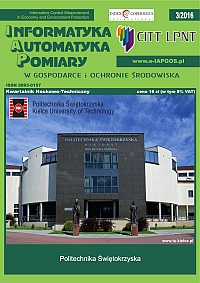IMPROVING OPTICAL FIBER SENSING BY MIMO SIGNAL PROCESSING
Article Sidebar
Open full text
Issue Vol. 6 No. 3 (2016)
-
METROLOGY IN UKRAINE
Oleksandr1 Huk, Orest Ivakhiv, Bohdan Stadnyk4-5
-
SELECTED METROLOGY PROBLEMS IMPLIED BY THE APPLICATION OF LED TECHNOLOGY IN LIGHTING
Urszula Błaszczak, Andrzej Stanisław Zając6-11
-
APPLICATION OF FLOW GRAPHS IN THE MICROWAVE MEASUREMENTS SYSTEMS
Przemysław Piróg12-15
-
APPROPRIATE CALIBRATION INTERVALS OF LABORATORY TEST EQUIPMENT IN ACCORDANCE WITH THE INTERNATIONAL IECEE REGULATIONS AND ITE PREDOM DIVISION ACTIVITY
Jan Łysko, Marek Starczewski, Joanna Walczak-Złotkowska16-19
-
MAINTENANCE OF TIME STANDARDS IN THE DEPARTMENT OF REFERENCE STANDARDS IN ZIELONKA. CONTRIBUTION INTO THE CREATION OF THE POLISH ATOMIC TIME SCALE TA (PL)
Marcin Gosztyła20-23
-
METHOD COMPARISON OF STATISTICAL AVERAGING ON THE HELMHOLTZ COILS CALIBRATION EXAMPLE
Mariusz Janeczko24-27
-
REALISATION OF RADIONUCLIDES ACTIVITY UNIT USING THE LIQUID SCINTILLATION COUNTING (LSC)
Ryszard Broda, Tomasz Dziel , Tomasz Ziemek , Anna Listkowska28-31
-
MEASUREMENTS OF PARAMETERS OF WATER AEROSOL OBTAINED BY EXPLOSIVE METHOD
Grzegorz Śmigielski, Roman Dygdała, Michał Kaczorowski, Grzegorz Serejko32-35
-
ACCURACY DIAGNOSTIC OF DIGITAL MULTIMETERS’ INDICATIONS
Roman Tabisz36-39
-
METROLOGICAL ANALYSIS OF DIFFERENT TECHNIQUES FOR MEASURING INTERFACE TENSION BETWEEN TWO FLUIDS BASED ON SPINNING DROP METHOD
Igor Kisil, Olga Barna, Yuriy Kuchirka40-42
-
HIGH FREQUENCY DC/DC CONVERTER BASED ON SIC TRANSISTORS FOR RES APPLICATION
Leszek Wolski43-46
-
COMPUTER MODELLING OF AUTOMATIC CONTROL PROCESS OF DISTILLATION COLUMN
Volodymyr Drevetskiy, Vasyl Ivanchuk47-50
-
IMPROVING OPTICAL FIBER SENSING BY MIMO SIGNAL PROCESSING
Andreas Ahrens, André Sandmann, Kort Bremer, Bernhard Roth, Steffen Lochmann51-55
-
TEMPERATURE DISTRIBUTION INSIDE CVD REACTOR AND ITS INFLUENCE AT CARBON NANOCONTAINERS SYNTHESIS PROCESS
Łukasz Pietrzak, Łukasz Wąs, Marcin Wyczechowski56-59
-
THE ALGORITHM OF THE PULSATILE MICROPUMP DRIVE CONTROL SYSTEM
Sebastian Bartel60-63
-
BIDIRECTIONAL DC/DC CONVERTER BUILT WITH THE USE OF SIC ELEMENTS
Wojciech Matelski, Leszek Wolski, Stanisław Abramik64-69
-
ANALYSIS AND DETECTION POSSIBILITY OF THE PARTIAL DISCHARGES IN AIR INSULATED MEDIUM VOLTAGE SWITCHGEAR USING TRANSIENT EARTH VOLTAGE DETECTION
Rafał Buczko, Andrzej Sikora70-74
-
MODEL OF CTG APARATUS IN LABVIEW ENVIRONMENT
Piotr Gumkowski, Wojciech Lecewicz, Wojciech Surtel75-78
Archives
-
Vol. 8 No. 4
2018-12-16 16
-
Vol. 8 No. 3
2018-09-25 16
-
Vol. 8 No. 2
2018-05-30 18
-
Vol. 8 No. 1
2018-02-28 18
-
Vol. 7 No. 4
2017-12-21 23
-
Vol. 7 No. 3
2017-09-30 24
-
Vol. 7 No. 2
2017-06-30 27
-
Vol. 7 No. 1
2017-03-03 33
-
Vol. 6 No. 4
2016-12-22 16
-
Vol. 6 No. 3
2016-08-08 18
-
Vol. 6 No. 2
2016-05-10 16
-
Vol. 6 No. 1
2016-02-04 16
-
Vol. 5 No. 4
2015-10-28 19
-
Vol. 5 No. 3
2015-09-02 17
-
Vol. 5 No. 2
2015-06-30 15
-
Vol. 5 No. 1
2015-03-31 18
-
Vol. 4 No. 4
2014-12-09 29
-
Vol. 4 No. 3
2014-09-26 22
-
Vol. 4 No. 2
2014-06-18 21
-
Vol. 4 No. 1
2014-03-12 19
Main Article Content
DOI
Authors
kort.bremer@hot.uni-hannover.de
bernhard.roth@hot.uni-hannover.de
Abstract
Optical fiber sensors have reached a high state of maturity. Besides the high number of sensor groups, multi-mode fiber evanescent field sensors can be found in a lot of applications. Here, the signal source commonly excites many optical modes under steady-state conditions. Perturbations of the fiber then produce leaky modes. Thus, a simple intensity detector measures the degree of perturbation. In some cases also restricted mode launching conditions have been applied. They resulted in higher sensitivity but showed a narrower measurement range. Considering the individual modes as carriers of information we adapted multiple-input multiple-output (MIMO) signal processing which is well studied in the telecommunications community, for improvements on both the sensor sensitivity and its measurement range. In this paper MIMO signal processing is investigated for fiber optic sensor applications. A (2x2) MIMO implementation is realized by using lower-order and higher-order mode groups of a gradient-index multi-mode fiber as separate transmission channels. A micro-bending pressure sensor changes these separate transmission characteristics and introduces additional crosstalk. By observing the layer specific weight-factors of the MIMO system the amount of load applied was determined. Experiments verified a good correlation between the change of the MIMO weight coefficients and the load applied to the sensor and thus verified that MIMO signal processing can beneficially be used for fiber optic sensor applications. The experimental results also verified the superior sensitivity and measurement range when MIMO signal processing is utilized.
Keywords:
References
Arik S., Kahn J.M., Ho K.P.: MIMO Signal Processing for Mode-Division Multiplexing. IEEE Signal Processing Magazine 25(2014).
Donlagic D.: Microbend sensor structure for use in distributed and quasidistributed Sensor Systems based on selective launching and filtering of the Modes in Graded Index Multimode Fiber. Journal of Lightwave Technology 17(10)/1999, 1856–1868.
Leung A., Shankar P., Mutharasan R.: A review of fiber-optic biosensors. Sensors and Actuators B 125/2007, 688–703.
Leung C.K.Y.: Optical Fiber Sensors for Civil Engineering Applications. Materials and Structures 48(4)/2015, 871–906.
Pankow J., Aust S., Lochmann S., Ahrens A.: Modulation-Mode Assignment in SVD-assisted Optical S. MIMO Multimode Fiber Links. 15th International Conference on Optical Network Design and Modeling (ONDM), Bologna 8–10 February 2011.
Richardson D.J., Fini J.M., Nelson L.E.: Space Division Multiplexing in Optical Fibres. Nature Photonics 7/2013, 354–362.
Sandmann A., Ahrens A., Lochmann S.: Experimental Description of Multimode MIMO Channels utilizing Optical Couplers. ITG- Fachbericht 248: Photonische Netze. Leipzig, VDE VERLAG GMBH, 05–06 May 2014, 125–130.
Su L., Chiang K.S., Lu C.: Microbend-induced mode coupling in a graded-index multimode fiber. Applied Optics 44(34)/2005, 7394–7402.
Zamarreno C.R., Hernaez M., Matias I., Arregui F.: Optical fiber sensors based on indium tin oxide surface plasmon resonance supporting coatings. Proc. OFS-20. Edinburgh, SPIE 75503, 2009.
Zhuang X., Li P., Yao J.: A Novel Approach to Evaluate the Sensitivities of the Optical Evanescent Field Sensors. Fiber Optic Sensors, Dr Moh. Yasin (Ed.) InTech, 2012.
Article Details
Abstract views: 728
License

This work is licensed under a Creative Commons Attribution-ShareAlike 4.0 International License.






